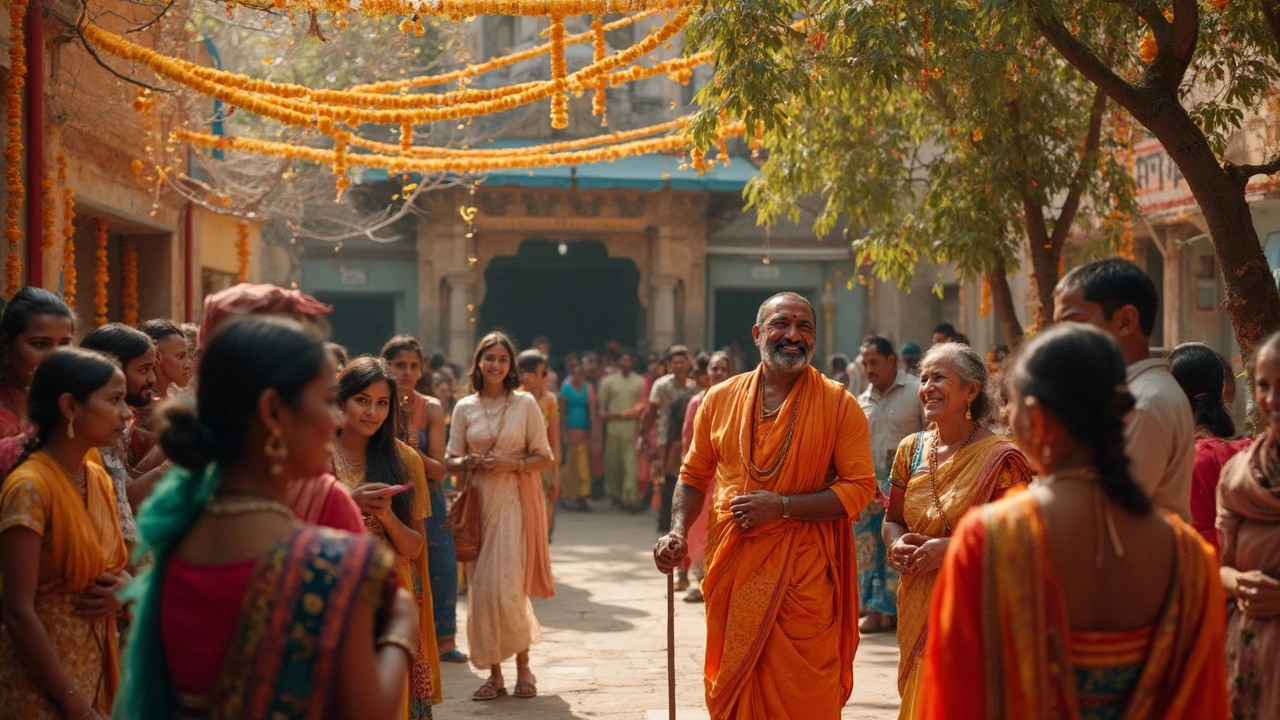Unique Temple in India: The Only One of Its Kind

There’s a temple in India that’s so unusual, people from all over the world come just to see it. Not just because it’s beautiful—India has temples on every corner, after all—but because it does something no other temple does. When you hear about the Karni Mata Temple in Rajasthan, you might not believe it. It’s famous for being the only place where thousands of rats are treated not as pests, but as holy creatures. Yes, seriously—rats.
This isn’t your typical travel stop. Folks show up here to witness the sight, pay their respects, and even share food with these furry residents. Seems wild, right? Yet the Karni Mata Temple is a one-off spot that refuses to fit the mold, and it’s got centuries of stories to back it up. Curious what makes this place tick, and if it’s worth adding to your travel list? Let’s break it down.
- What Makes a Temple 'Only One'?
- The Karni Mata Temple: Where Rats Rule
- Curious Rituals and Local Legends
- Tips for Visiting India’s Strangest Temples
What Makes a Temple 'Only One'?
India has around 2 million temples, each with its own story and crowd. But the label 'only one' isn’t about size, age, or even location. It’s about something so unique that it doesn’t exist anywhere else in the world—features, rituals, or residents that break the mold.
Take the Karni Mata Temple: where else can you find a place with over 25,000 rats living freely and worshipped every day? No copies, no spin-offs, just this one spot in Rajasthan.
When people talk about a unique temple India, what they mean is a temple that ticks at least one of these boxes:
- It’s got a ritual or belief completely different from any other temple.
- There’s a feature—like animal inhabitants—that you won’t find anywhere else.
- Locals and visitors treat it like the ‘one and only’ of its kind for religious or cultural reasons.
| Temple Name | Unique Feature | Location |
|---|---|---|
| Karni Mata Temple | Home to 25,000+ sacred rats | Deshnok, Rajasthan |
| Kodungallur Bhagavathy Temple | Bharani festival rituals not seen elsewhere | Kerala |
| Stambheshwar Mahadev | Submerged by tides twice daily | Gujarat |
But none pull visitors quite like Karni Mata. BBC called it ‘the world’s strangest place of worship.’
“It’s not just the animals; it’s the way people honor them that makes this temple so startling,” reports BBC Travel.
This sort of thing is what cements a temple’s status as a true one-off. Tourists snap photos, locals offer sweets, and those sacred rats become legends. Looking for an experience you won’t get again anywhere else? This is it.
The Karni Mata Temple: Where Rats Rule
Step into Deshnoke, Rajasthan, and you hit the Karni Mata Temple—a spot famous for its residents: over 25,000 rats. Locals call these rats "kabbas," and, wild as it sounds, people here treat them as family. This isn’t a myth. These rats run everywhere, from altars to the marble floors, and they get more respect than most street dogs get anywhere else in the world.
The story behind this unique temple India says Karni Mata, a 14th-century mystic, asked Yama (the god of death) to bring her stepson back to life. Yama said no, so she performed a miracle. Her devotees believe the souls of Karni Mata’s followers now come back as rats—no endless cycle of life and death, just rat life inside the temple, where food and safety are guaranteed.
"The Karni Mata Temple is one of the most unusual religious sites in India. Nowhere else do rats and people share the same sacred space so harmoniously." – BBC Travel
Inside, rats go about their day: eating, sleeping, exploring. Visitors try to spot a rare white rat, thought to bring luck if seen. Here, stepping on a rat is a big deal. If you do, you’re expected to buy a silver rat statue as an apology. Sharing prasad—food offered to the rats—is seen as a blessing, not a dare. Hygiene freaks won’t love it, but most folks come away believing they’ve been part of something special.
| Fun Fact | Details |
|---|---|
| Number of Rats | Over 25,000 |
| Temple Age | Constructed in late 19th century by Maharaja Ganga Singh |
| Most Sought-After Sighting | White rat (considered extra lucky) |
| Opening Hours | 24/7, but best early morning or late evening |
Best hack? Wear closed shoes, watch your step, and bring a camera that handles low light—rats are most active around dawn and dusk. Expect the unexpected and don’t be surprised if a rat runs over your foot. Folks visiting leave with more stories than souvenirs.

Curious Rituals and Local Legends
If you ask locals why the Karni Mata Temple does what it does, you’ll get stories that sound straight out of a movie. People don’t just come for a regular prayer—they join rituals that respect and even celebrate rats, or as they call them, "kabbas." At last count, more than 25,000 of these holy rats call the temple home.
Visitors remove their shoes before entering and some even try to feed the rats treats like sweets and grains. A few tourists are startled to see the rats drinking from the temple’s milk bowls, but for believers, this is a big deal. Spotting an all-white rat among the sea of brown ones? Locals say it’s a sign of good luck—some wait hours just for a glimpse.
Here's what makes the unique temple India experience so memorable:
- Offerings made to the rats are considered blessed, so visitors sometimes eat what’s left behind—definitely not something you see at any other shrine.
- The temple has rules to protect its furry residents. Accidentally step on a rat? Tradition says you must replace it with a silver or gold replica.
How do the priests handle this? Simple—they live alongside the rats every day, cleaning the temple and making sure there’s enough food. Everything centers around the legend of Karni Mata herself. She was a female mystic from the 15th century, and locals believe she could bring the dead back to life—but only in the form of rats. It’s a tale everyone here knows by heart.
For a sense of how important these critters are, check out this data from temple authorities:
| Fact | Detail |
|---|---|
| Total rats in temple | 25,000+ |
| Temple meals cooked for rats daily | Over 50 kg grains & sweets |
| Rare white rats | About 4-5 reported at any time |
As one religious guide, Priya Soni, explained to National Geographic,
"For us, these rats represent the family of Karni Mata. Sharing food with them is like offering food to our goddess herself."
None of this is put on for tourists—it’s a daily ritual that’s been happening for hundreds of years. It might seem odd to outsiders, but here, it’s a unique mix of faith, history, and community you honestly won’t find anywhere else.
Tips for Visiting India’s Strangest Temples
If you’re planning to check out the unique temple India is known for—especially Karni Mata Temple—you’ll want to come prepared. These places aren’t your typical tourist sites, and a visit can be a bit of a culture shock if you haven’t done your homework. Here’s what you need to know.
- Footwear is a no-go inside: Many temples, especially Karni Mata, have a strict no-shoes rule. And at Karni Mata, you’ll be walking barefoot right where the rats are, so maybe pack some hand sanitizer for after.
- Rats have the right of way: In Karni Mata Temple, the rats (called kabas) are everywhere. Locals believe spotting a white rat is extra lucky. Step carefully, because you’re supposed to avoid harming even a single one. Folks say if you accidentally step on one, you’ll need to offer a tiny silver rat statue to the temple.
- Bring a spare set of clothes: The temple can be packed, especially on festivals. Clothing can get dirty, and if you’re not used to animals, things might feel a little overwhelming.
- Photography rules vary: Some temples allow photos (even of the rats), but others are strict about cameras or smartphones. Always ask what’s allowed before snapping away.
- Don’t skip the local legends: Spend time chatting with the temple caretakers. You’ll hear wild stories that don’t make it into guidebooks, and you’ll get a different view altogether.
Best times to visit? Go early in the morning or late afternoon. That way you avoid the maddest crowds and the hottest part of the day. Here’s a quick table with handy info if you’re aiming for the Karni Mata Temple:
| Fact | Detail |
|---|---|
| Location | Deshnoke, near Bikaner, Rajasthan |
| Opening Hours | 4:30 AM – 10:00 PM |
| Entry Fee | Free (Camera fee: 30-50 INR) |
| Peak Visitor Time | Navratri festival (March-April & September-October) |
| Unique Feature | 20,000+ rats, special status for white rats |
Last thing—bring snacks or water, but double-check before eating. Temple rules on food can be strict, and you don’t want to cause offense. If you’re feeling brave, you can try the prasad (offerings) that the rats have nibbled—it’s said to be blessed, but, yeah, not for everyone. I’ve seen Adelaide give it a miss more than once, and I don’t blame her! Just remember, these places are about respect and soaking up a completely different vibe than you’ll find anywhere else.